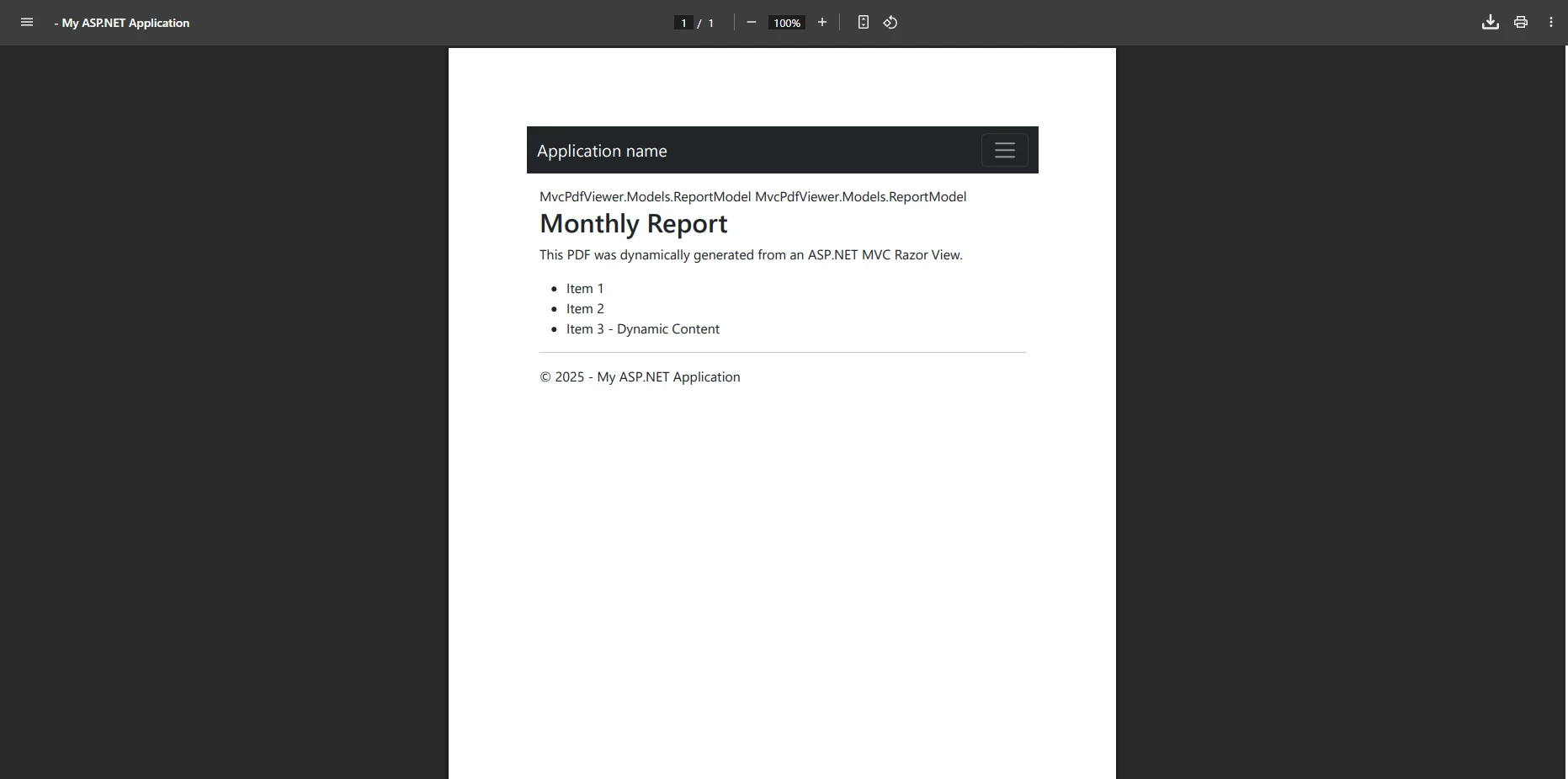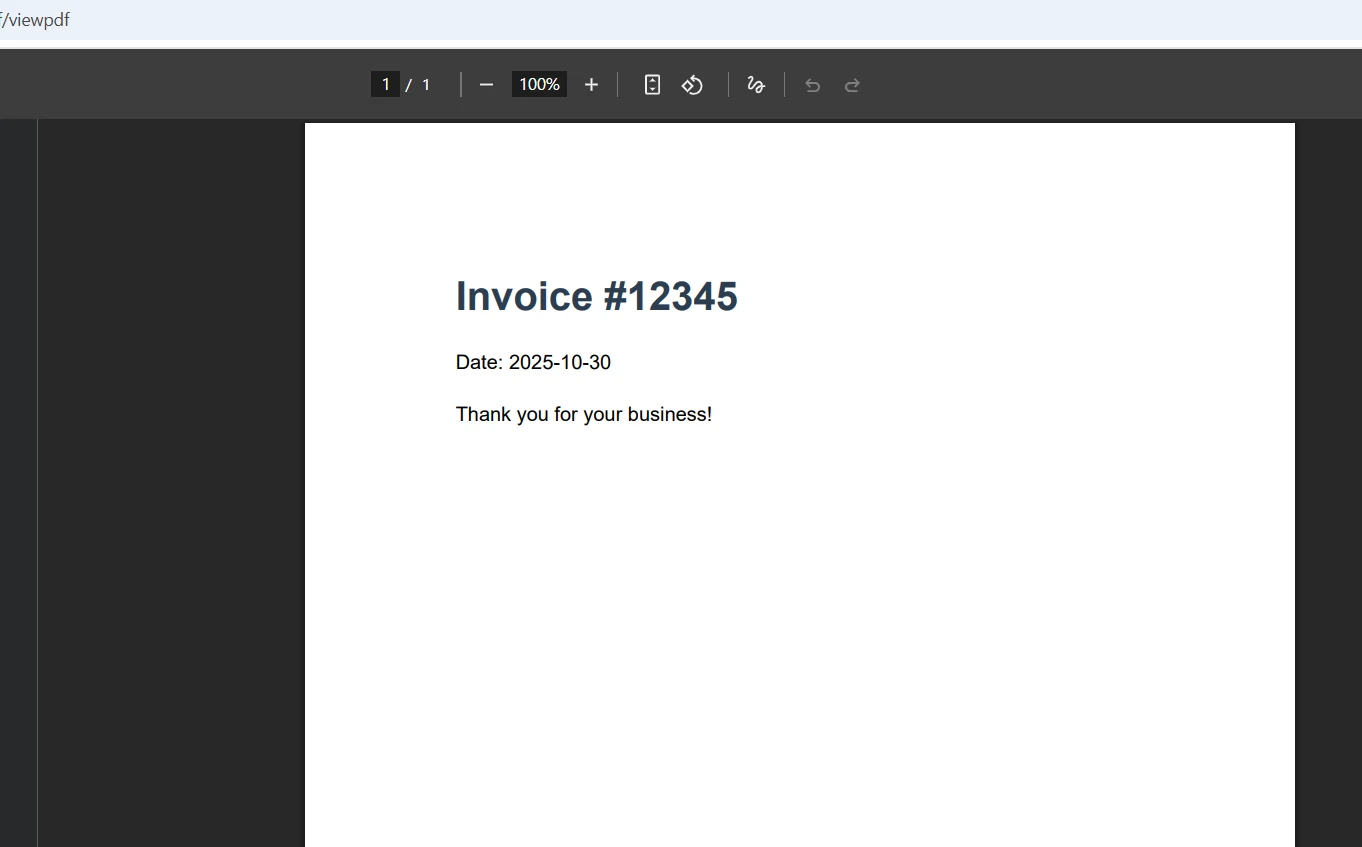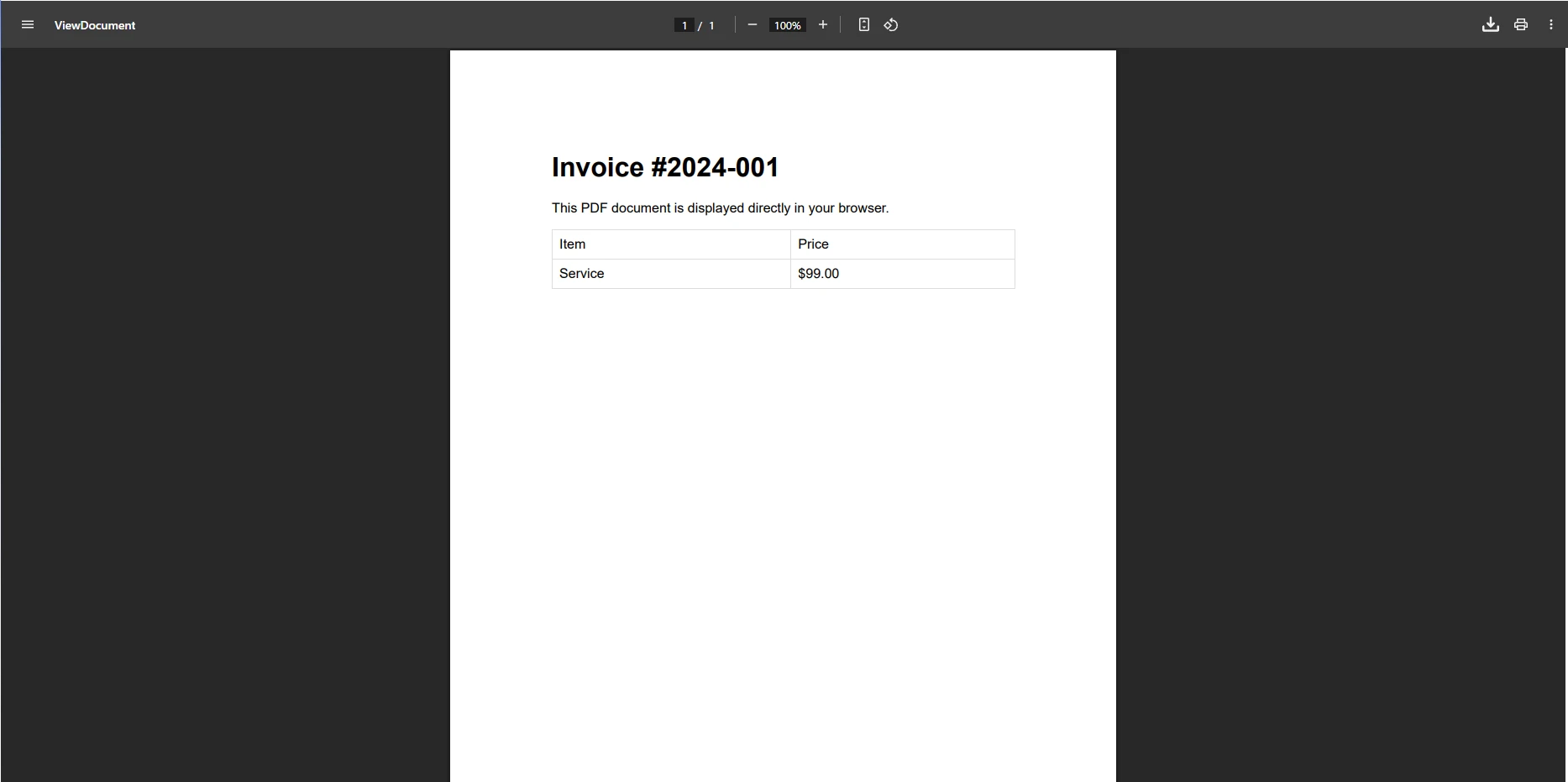How to Create an ASP.NET MVC PDF Viewer
Building a robust PDF viewer for your ASP.NET MVC applications doesn't require complex JavaScript libraries or third-party viewer controls. With IronPDF, you can create a powerful MVC PDF viewer control that handles everything from displaying PDF files to generating dynamic PDF documents directly from your views.
This article will show you how to implement a complete ASP.NET MVC PDF viewer solution that works seamlessly across all browsers. We'll also show how you can implement features like text selection, form filling, and responsive display for modern web applications. Before you upload and view your first file, make a note of our comprehensive documentation.
Download IronPDF and see how easy it is to build your own .NET MVC PDF viewer control with just a few lines of code.
How Do You Create an ASP.NET MVC PDF Viewer?
Setting up your ASP-based PDF viewer starts with installing IronPDF through NuGet Package Manager. This .NET PDF viewer control provides server-side processing capabilities that eliminate browser compatibility issues. For detailed installation guidance, refer to the IronPDF installation documentation.
Install-Package IronPdf
In your ASP.NET MVC controller, add the essential namespaces:
using IronPdf;
using System.Web.Mvc;using IronPdf;
using System.Web.Mvc;IRON VB CONVERTER ERROR developers@ironsoftware.comThese imports enable your web application to handle PDF rendering and display. The ChromePdfRenderer class serves as the core component for your MVC PDF viewer control, providing methods to create, manipulate, and display PDF files directly in users' browsers. Unlike client-side solutions, IronPDF processes everything on the server, ensuring consistent rendering across all devices and browsers while maintaining control over your PDF documents. A key advantage of this approach is its security.
How to Display PDF Files in Your .NET MVC Web Application?
Creating a PDF viewer control that displays existing PDF files requires implementing a controller action that returns the document as a FileResult. This approach enables users to view PDF pages directly in their browser without the need to upload or select a file manually. For more advanced scenarios, explore IronPDF's rendering options.
public FileResult DisplayPdf(string fileName)
{
// Load existing PDF document
var pdfPath = Server.MapPath($"~/Content/PDFs/{fileName}");
PdfDocument pdf = PdfDocument.FromFile(pdfPath);
// Set response headers to display in browser
Response.Headers.Add("Content-Disposition", "inline; filename=" + fileName);
// Return PDF to the browser
return File(pdf.BinaryData, "application/pdf");
}public FileResult DisplayPdf(string fileName)
{
// Load existing PDF document
var pdfPath = Server.MapPath($"~/Content/PDFs/{fileName}");
PdfDocument pdf = PdfDocument.FromFile(pdfPath);
// Set response headers to display in browser
Response.Headers.Add("Content-Disposition", "inline; filename=" + fileName);
// Return PDF to the browser
return File(pdf.BinaryData, "application/pdf");
}IRON VB CONVERTER ERROR developers@ironsoftware.comThis code loads a PDF document from your server's file system and sends it to the browser. The Content-Disposition: inline header tells the browser to display PDF files within the viewport rather than triggering a download. The PdfDocument.FromFile method reads the existing file, while pdf.BinaryData provides the byte array needed for streaming.
This simple implementation creates a functional MVC PDF viewer that handles various file sizes efficiently. For responsive viewing, the browser automatically adjusts the display based on viewport dimensions, ensuring your PDF viewer works on mobile devices. According to Stack Overflow discussions, this server-side approach provides better control than embedding plugins. It also works well with screen readers.
Output PDF

How to Convert Views to PDF Documents?
Your ASP.NET MVC PDF viewer can dynamically generate PDF documents from Razor views, enabling data-driven document creation. This powerful feature lets you convert any view into a professionally formatted PDF. Learn more about converting CSHTML to PDF.
public FileResult GeneratePdfFromView()
{
// Sample data for the view
var model = new ReportModel
{
Title = "Monthly Report",
Data = ReportModel.GetReportData()
};
// Initialize renderer
var renderer = new ChromePdfRenderer();
// Configure rendering options
renderer.RenderingOptions.MarginTop = 25;
renderer.RenderingOptions.MarginBottom = 25;
renderer.RenderingOptions.EnableJavaScript = true;
// Render MVC view to PDF
var pdf = renderer.RenderView(this.HttpContext,
"~/Views/Reports/Monthly.cshtml",
model);
// Display in browser
Response.Headers.Add("Content-Disposition", "inline");
return File(pdf.BinaryData, "application/pdf");
}public FileResult GeneratePdfFromView()
{
// Sample data for the view
var model = new ReportModel
{
Title = "Monthly Report",
Data = ReportModel.GetReportData()
};
// Initialize renderer
var renderer = new ChromePdfRenderer();
// Configure rendering options
renderer.RenderingOptions.MarginTop = 25;
renderer.RenderingOptions.MarginBottom = 25;
renderer.RenderingOptions.EnableJavaScript = true;
// Render MVC view to PDF
var pdf = renderer.RenderView(this.HttpContext,
"~/Views/Reports/Monthly.cshtml",
model);
// Display in browser
Response.Headers.Add("Content-Disposition", "inline");
return File(pdf.BinaryData, "application/pdf");
}IRON VB CONVERTER ERROR developers@ironsoftware.comThe RenderView method converts your CSHTML view into a PDF document, maintaining all styling and layout. The RenderingOptions allow you to control margins, enable JavaScript execution, and configure other display properties. This server-side rendering ensures consistent output regardless of the user's browser or device.
The generated PDF pages preserve your view's responsive design elements, automatically adapting content for optimal display. For complex layouts, you can also add headers and footers to create professional documents. This is a very lightweight solution compared to most client-side alternatives.
Rendered View Output

What Features Can You Add to Your PDF Viewer?
Modern PDF viewer control implementations require interactive features beyond basic display. IronPDF enables text selection and text search capabilities automatically when rendering PDF files. Users can highlight and copy content directly from the displayed document. These features enhance the user experience and make your ASP.NET MVC PDF viewer more functional.
public FileResult ViewPdfWithFeatures(int documentId = 1)
{
// Load the PDF document object
var pdf = LoadPdfDocument(documentId);
if (pdf == null)
{
// Handle file not found (returns nothing, which will result in a 404 or empty response)
return null;
}
pdf.SecuritySettings.AllowUserFormData = true;
pdf.Bookmarks.AddBookMarkAtStart("Table of Contents", 1);
pdf.Bookmarks.AddBookMarkAtStart("Chapter 1", 5);
// Configure viewer toolbar
Response.Headers.Add("Content-Disposition",
"inline; filename=document.pdf#toolbar=1");
return File(pdf.BinaryData, "application/pdf");
}public FileResult ViewPdfWithFeatures(int documentId = 1)
{
// Load the PDF document object
var pdf = LoadPdfDocument(documentId);
if (pdf == null)
{
// Handle file not found (returns nothing, which will result in a 404 or empty response)
return null;
}
pdf.SecuritySettings.AllowUserFormData = true;
pdf.Bookmarks.AddBookMarkAtStart("Table of Contents", 1);
pdf.Bookmarks.AddBookMarkAtStart("Chapter 1", 5);
// Configure viewer toolbar
Response.Headers.Add("Content-Disposition",
"inline; filename=document.pdf#toolbar=1");
return File(pdf.BinaryData, "application/pdf");
}IRON VB CONVERTER ERROR developers@ironsoftware.comThis implementation enables form-filling functionality, allowing users to submit PDF form data directly in the browser. The bookmark additions create a navigable structure for easy navigating through long documents. The built-in toolbar parameter in the Content-Disposition header ensures browser tools for zoom, print, and download are accessible to users.
These features transform a basic display into a comprehensive ASP.NET MVC PDF viewer that supports full document interaction. For advanced scenarios, explore IronPDF's annotation capabilities to add comments and annotations to your PDF pages. Use keyboard shortcuts like Ctrl + F for quick searching of text occurrences.
Output

How to Secure Your PDF Viewer Control?
Security is crucial when implementing a PDF viewer in your web application. IronPDF provides multiple layers of protection for sensitive PDF documents. According to Microsoft's security best practices, server-side processing offers better control than client-side libraries.
public FileResult SecurePdfView(string documentId)
{
var pdf = GenerateConfidentialPdf();
// Apply security settings
pdf.SecuritySettings.UserPassword = "MySecretPassword";
pdf.SecuritySettings.OwnerPassword = "OwnerSecretPassword";
pdf.SecuritySettings.AllowUserPrinting = PdfPrintSecurity.NoPrint;
pdf.SecuritySettings.AllowUserCopyPasteContent = false;
pdf.SecuritySettings.AllowUserEdits = IronPdf.Security.PdfEditSecurity.NoEdit;
// Prevent unauthorized downloads
Response.Headers.Add("X-Frame-Options", "SAMEORIGIN");
Response.Headers.Add("Content-Security-Policy", "frame-ancestors 'self'");
return File(pdf.BinaryData, "application/pdf");
}public FileResult SecurePdfView(string documentId)
{
var pdf = GenerateConfidentialPdf();
// Apply security settings
pdf.SecuritySettings.UserPassword = "MySecretPassword";
pdf.SecuritySettings.OwnerPassword = "OwnerSecretPassword";
pdf.SecuritySettings.AllowUserPrinting = PdfPrintSecurity.NoPrint;
pdf.SecuritySettings.AllowUserCopyPasteContent = false;
pdf.SecuritySettings.AllowUserEdits = IronPdf.Security.PdfEditSecurity.NoEdit;
// Prevent unauthorized downloads
Response.Headers.Add("X-Frame-Options", "SAMEORIGIN");
Response.Headers.Add("Content-Security-Policy", "frame-ancestors 'self'");
return File(pdf.BinaryData, "application/pdf");
}IRON VB CONVERTER ERROR developers@ironsoftware.comThese security measures protect your PDF files from unauthorized access and distribution. The password protection requires authentication before viewing, while permission settings prevent copying or printing sensitive content. The security headers prevent embedding your PDF viewer control in unauthorized external sites. This is especially helpful when protecting confidential documents.
For additional security options, explore IronPDF's password and permissions documentation.
Conclusion
IronPDF transforms ASP.NET MVC applications into powerful document management systems with its comprehensive PDF viewer capabilities. From basic file display to advanced features like form filling and text search, you can build a professional MVC PDF viewer control that meets modern web application requirements. The server-side processing ensures consistent rendering across all platforms while maintaining security and control over your PDF documents. Whether you need to display PDF files, create dynamic reports, or add interactive UI elements, IronPDF provides the tools and documentation to support your development process.
Ready to implement your own ASP.NET MVC PDF viewer? Start your free trial to choose the right plan for your team.

















